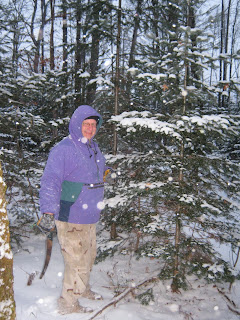 |
| Asher keeping an eye on a chickadee |
 |
| Asher watching goldfinch gathering at feeder |
We feed the birds two different types of seeds: black-oil sunflower seed and thistle seed. Here are some facts about these seeds from
Top 10 Foods for Winter Bird Feeding
Black-oil sunflower seed. This seed is the hamburger of the bird world. Almost any bird that will visit a bird feeder will eat black-oil sunflower. Birds that can’t crack the seeds themselves will scour the ground under the feeders, picking up bits and pieces. Bird feeding in North America took a major leap forward when black-oil sunflower became widely available in the early 1980s. Why do birds prefer it? The outer shell of a black-oil sunflower seed is thinner and easier to crack. The kernel inside the shell is larger than the kernel inside a white-or gray-striped sunflower seed, so birds get more food per seed from black-oil. This last fact also makes black-oil a better value for you, the seed buyer.
Nyjer/thistle seed. Although it can be expensive, Nyjer, or thistle, seed is eagerly consumed by all the small finches–goldfinches, house, purple, and Cassin’s finches, pine siskins, and redpolls. You need to feed thistle in a thistle feeder of some kind–the two most commonly used types of thistle feeder are a tube feeder with small thistle-seed-sized holes, and a thistle sock. A thistle sock is a sock-shaped, fine-mesh, synthetic bag that is filled with thistle seed. Small finches can cling to this bag and pull seeds out through the bag’s mesh. Two potential problems with thistle: it can go rancid or moldy quickly in wet weather and uneaten seeds can germinate in your yard, creating a patch of thistle (Guizotia abyssinica) plants that you may not want. Fortunately, this problem does not seem to be widespread. All thistle seed is imported to North America, and it is all supposed to be sterilized prior to entry into the United States and Canada.
O Christmas Tree! O Christmas Tree!
Much pleasure thou can'st give me.
 |
| Pete bringing our tree home |
 |
| Our decorated Christmas tree |
I was listening to Science Friday on the radio yesterday and there was a very interesting discussion on Christmas trees. Adding aspirin or sugar to the water in a tree does not help the tree keep its needles longer. According to Raj Lada, Professor and Founding Director, Christmas Tree Research Center the hormone, ethylene, of the tree determines how long it will last. The activation of this hormone makes the needles drop. The folks as the Christmas Tree Research Center have been able to block activation of the hormone by adding an inhibitor to the water in the tree stand. The inhibitor is not available commercially yet.
The Center also did some research on lights. They found that trees with white lights got nearly 30, 35 days better needle retention capacity compared to the dark-retained ones, or the controls with the normal lighting and the worst performer in the experiment were the blue lights. Dr. Lada also said you should not turn your lights off at night. If you keep the tree in the dark, it will respire more, and then it'll use all its carbohydrates - it can be starved to death.
 |
| Our tree at night |
When you bring your tree home, give it a fresh cut, basically, at least about an inch from the previous cut - at least about an inch, and then put it in water. See that your water level is not depleted every single day and refill it. Don't forget to refill the reservoir - that's one of the most important things. And don't turn your lights off at night.

No comments:
Post a Comment